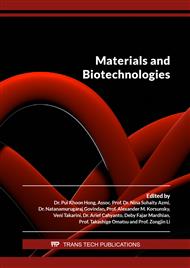[1]
Chow LC. Development of self-setting calcium phosphate cements. Nippon Seramikkusu Kyokai Gakujutsu Ronbunshi/Journal Ceram Soc Japan. 1991;99(1154):954–64.
DOI: 10.2109/jcersj.99.954
Google Scholar
[2]
Brown WE, Chow LC. Paste mineralizers and cements. 1986. p. US Patent No.4612053.
Google Scholar
[3]
Ishikawa K. Calcium phosphate cement. In: Kokubo T, editor. Bioceramics and their clinical applications. Woodhead Publishing anf Maney Publishing; 2008. p.438–62.
Google Scholar
[4]
Ambard AJ, Mueninghoff L. Calcium phosphate cement: Review of mechanical and biological properties. J Prosthodont. 2006;15(5):321–8.
DOI: 10.1111/j.1532-849x.2006.00129.x
Google Scholar
[5]
Dorozhkin S V. Calcium orthophosphate cements for biomedical application. J Mater Sci. 2008;43(9):3028–57.
DOI: 10.1007/s10853-008-2527-z
Google Scholar
[6]
Ishikawa K, Asaoka K. Estimation of ideal mechanical strength and critical porosity of calcium phosphate cement. J Biomed Mater Res. 1995;29(12):1537–43.
DOI: 10.1002/jbm.820291210
Google Scholar
[7]
Watanabe M, Tanaka M, Sakurai M, Maeda M. Development of calcium phosphate cement. J Eur Ceram Soc. 2006;26(4–5):549–52.
Google Scholar
[8]
Dos Santos LA, De Oliveira LC, Da Silva Rigo EC, Garcia Carrodéguas; R, Boschi AO, De Arruda ACF. Fiber reinforced calcium phosphate cement. Artif Organs. 2000;24(3):212–6.
DOI: 10.1046/j.1525-1594.2000.06541.x
Google Scholar
[9]
Hesaraki S, Alizadeh M, Borhan S, Pourbaghi-Masouleh M. Polymerizable nanoparticulate silica-reinforced calcium phosphate bone cement. J Biomed Mater Res - Part B Appl Biomater. 2012;100 B(6):1627–35.
DOI: 10.1002/jbm.b.32731
Google Scholar
[10]
El-Ghannam AR. Advanced bioceramic composite for bone tissue engineering: Design principles and structure-bioactivity relationship. J Biomed Mater Res - Part A. 2004;69(3):490–501.
DOI: 10.1002/jbm.a.30022
Google Scholar
[11]
Cahyanto A, Rezano A, Zakaria MN, El-Ghannam A. Synthesis and Characterization of a Novel SCPC-CO3Ap Cement for Pulp Capping Application in Dentistry. Key Eng Mater. 2017;758:29–33.
DOI: 10.4028/www.scientific.net/kem.758.29
Google Scholar
[12]
Zakaria MN, Cahyanto A, El-Ghannam A. Basic properties of novel bioactive cement based on silica-calcium phosphate composite and carbonate apatite. Key Eng Mater. 2017;720:147–52.
DOI: 10.4028/www.scientific.net/kem.720.147
Google Scholar
[13]
Kokubo T, Takadama H. Simulated Body Fluid (SBF) as a Standard Tool to Test the Bioactivity of Implants. In: Handbook of Biomineralization: Biological Aspects and Structure Formation. 2008. p.97–109.
DOI: 10.1002/9783527619443.ch51
Google Scholar
[14]
Bohner M, Lemaitre J. Can bioactivity be tested in vitro with SBF solution? Biomaterials 2009;30(12):2175–9.
DOI: 10.1016/j.biomaterials.2009.01.008
Google Scholar
[15]
Kokubo T, Takadama H. How useful is SBF in predicting in vivo bone bioactivity? Biomaterials. 2006;27(15):2907–15.
DOI: 10.1016/j.biomaterials.2006.01.017
Google Scholar
[16]
Artilia I, Zakaria MN, Cahyanto A. Setting time, handling property and mechanical strength evaluation of SCPC50 and apatite cement mixture in various combinations. Key Eng Mater. 2019;829:40–5.
DOI: 10.4028/www.scientific.net/kem.829.40
Google Scholar
[17]
Yücel S, Aydin I, Özçimen D, Tekerek BS, Yildirim Ö, Kabakci A. Effect of simulated body fluid on the behaviour of artificial bone composite material extended by hydroxyapatite and silicate powders. Key Eng Mater. 2012;493–494:159–65.
DOI: 10.4028/www.scientific.net/kem.493-494.159
Google Scholar
[18]
Kim HM, Himeno T, Kawashita M, Kokubo T, Nakamura T. The mechanism of biomineralization of bone-like apatite on synthetic hydroxyapatite: An in vitro assessment. J R Soc Interface. 2004;1(1):17–22.
DOI: 10.1098/rsif.2004.0003
Google Scholar
[19]
Bonar LC, Roufosse AH, Sabine WK, Grynpas MD, Glimcher MJ. X-ray diffraction studies of the crystallinity of bone mineral in newly synthesized and density fractionated bone. Calcif Tissue Int. 1983;35(1):202–9.
DOI: 10.1007/bf02405032
Google Scholar
[20]
Ishikawa K. Bone substitute fabrication based on dissolution-precipitation reactions. Materials (Basel). 2010;3(2):1138–55.
DOI: 10.3390/ma3021138
Google Scholar
[21]
Wang X, Ye J, Wang Y, Wu X, Bai B. Control of crystallinity of hydrated products in a calcium phosphate bone cement. J Biomed Mater Res. 2007;81(A)(4):781-90.
DOI: 10.1002/jbm.a.31059
Google Scholar



